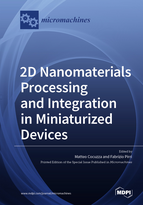2D Nanomaterials Processing and Integration in Miniaturized Devices
A special issue of Micromachines (ISSN 2072-666X). This special issue belongs to the section "D:Materials and Processing".
Deadline for manuscript submissions: closed (1 July 2020) | Viewed by 30340
Special Issue Editors
Interests: nanotechnologies applied to biological systems (in particular sensors, lab on chip, and organ on chip); graphene and 2D materials for energy and environment (solar cells, supercapacitors); nanomaterials for microelectronics; nanomaterials and nanostructures for CO2 trapping and reduction; multifunctional nanocomposites for 3D printing
Special Issues, Collections and Topics in MDPI journals
2. Institute of Materials for Electronics and Magnetism, IMEM-CNR, Parco Area delle Scienze 37/A, 43124 Parma, Italy
Interests: microsystems; microfluidics; polymeric 3D printing; OECTs; MXenes
Special Issues, Collections and Topics in MDPI journals
Special Issue Information
Dear Colleagues,
A relatively populous and ever-expanding class of innovative materials are 2D nanomaterials with a disruptive potential for different application contexts. Although for some of them, such as graphene, various possible implementations have already been explored in different application fields, others, (e.g. Mxenes), are still relatively at an infantile stage with regard to handling, stability, exploitation, processing, and practical use in devices and higher dimensionality structures. In any case, regardless of the specific nature of each of these materials, their degree of purity, and structure (mono-layers / few-layers / multi-layers) and their level of maturity, they all share the same challenges from their onset, such asprocessing, patterning, transfer, and integration in devices allowing a smart exploitation of their unique properties, incorporation in matrices of different nature for the synthesis of nanocomposites, and so on. Accordingly, this Special Issue aims to showcase research papers, short communications, and review articles outlining recent progress and innovative approaches for 2D nanomaterials synthesis and/or processing, preparatory to their assembly or integration into devices, microstructures, microsensors, and composites for different application fields. Descriptions of subsequent miniaturized devices and systems (MEMS, microsensors, devices for different application fields like energy, bio, environment,etc.) integrating 2D nanomaterials are welcome and strongly encouraged.
Prof. Dr. Candido Fabrizio Pirri
Dr. Matteo Cocuzza
Guest Editors
Manuscript Submission Information
Manuscripts should be submitted online at www.mdpi.com by registering and logging in to this website. Once you are registered, click here to go to the submission form. Manuscripts can be submitted until the deadline. All submissions that pass pre-check are peer-reviewed. Accepted papers will be published continuously in the journal (as soon as accepted) and will be listed together on the special issue website. Research articles, review articles as well as short communications are invited. For planned papers, a title and short abstract (about 100 words) can be sent to the Editorial Office for announcement on this website.
Submitted manuscripts should not have been published previously, nor be under consideration for publication elsewhere (except conference proceedings papers). All manuscripts are thoroughly refereed through a single-blind peer-review process. A guide for authors and other relevant information for submission of manuscripts is available on the Instructions for Authors page. Micromachines is an international peer-reviewed open access monthly journal published by MDPI.
Please visit the Instructions for Authors page before submitting a manuscript. The Article Processing Charge (APC) for publication in this open access journal is 2600 CHF (Swiss Francs). Submitted papers should be well formatted and use good English. Authors may use MDPI's English editing service prior to publication or during author revisions.
Keywords
- 2D Nanomaterials
- Graphene
- Transition Metal Dichalcogenides
- Boron Nitride
- Metal Oxide Nanosheets
- Mxenes
- Integration
- Composites
- Miniaturized Devices
- Microsensors
- Microfluidics
- Energy Devices
- Bio Devices







